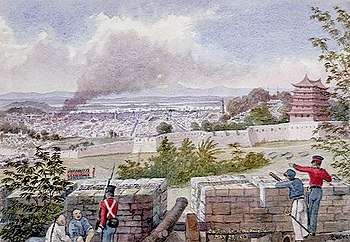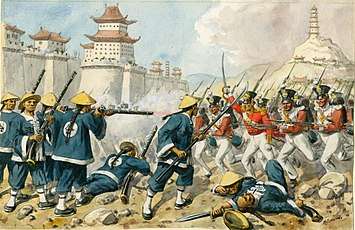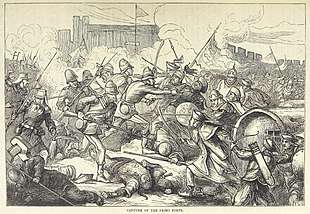Opium Wars
The Opium Wars were two wars which were waged between the Qing dynasty and Western powers in the mid-19th century. The First Opium War, fought in 1839-1842 between the Qing and Great Britain, was triggered by the dynasty's campaign against the opium trade; the Second Opium War was fought between the Qing and Britain and France, 1856-1860. In each war, the European forces used recently developed warfare technology to defeat the Qing forces and compelled the government to grant favorable tariffs, trade concessions, and territory.

The wars and the subsequently-imposed treaties weakened the Qing dynasty and Chinese governments, and forced China to open specified treaty ports (especially Shanghai and Guangzhou (Canton)) that handled all trade with imperial powers.[1][2] The resulting concession of Hong Kong after the wars compromised China's territorial sovereignty.
Around this time China's economy also contracted slightly, but the sizable Taiping Rebellion and Dungan Revolt had a much larger effect.[3]
First Opium War

The First Opium War began in 1839 and was fought over trade, financial reparations, and diplomatic status.[4] In the eighteenth century, China enjoyed a favorable trade balance with Europe, selling porcelains, silk, and tea in exchange for silver. In the late 18th century, the British East India Company, expanded cultivation of opium in its territories in Bengal. It sold this Indian opium to private traders who transported it to China and sold it to Chinese smugglers.[5] By 1787, the Company was sending 4,000 chests of opium (each weighing 77 kg) to China a year.[6]
In earlier times, opium was ingested for medicinal purposes, and relatively harmless, but the new practice of smoking opium made its use recreational, and even if not always addictive, increased demand tremendously. The Chinese Jiaqing Emperor issued edicts making opium illegal in 1729, 1799, 1814, and 1831, but imports grew as smugglers found it handsomely profitable and shared their wealth with local officials. [7] Some Americans entered the trade by smuggling lower priced opium from Turkey into China. By 1833, the number of chests of opium trafficked into China soared to 30,000.[6] According to United Nations Office on Drugs and Crime, the East India Company sent the opium to their warehouses in the free-trade region of Canton (Guangzhou), from where Chinese smugglers would take the opium farther into China.[7] In 1834, the East India Company's monopoly ceased.[8]
The illegal trade, however, burgeoned. Partly concerned with the moral problem and partly with the outflow of silver, the Emperor placed matters in the hands of High Commissioner Lin Tse-hsu. In 1839, Commissioner Lin published a Letter To Queen Victoria in Canton pleading for a halt to the opium contraband, but did not send it to the Queen. Lin issued an edict ordering the seizure of all opium in Canton, including that held by foreign governments and traders.[9] Lin initially offered to let foreign companies to forfeit their opium stores in exchange for tea, but this failed. He then confiscated all supplies and ordered a blockade of foreign ships to get them to surrender their illegal opium supply. The smugglers lost 20,000 chests (1,300 metric tons) of opium without compensation.[7]
The British trade commissioner in Canton, Captain Charles Elliot, wrote to London advising the use of military force against the Chinese. Almost a year passed before the British government decided, in May 1840, to send troops to impose reparations for the economic losses of the British traders in Canton, including financial compensation, and to guarantee future security for trade. However, the first hostilities had occurred some months earlier with a skirmish between British and Chinese vessels in the Kowloon Estuary on 4 September 1839.[9] On 21 June 1840 a British naval force arrived off Macao and moved to bombard the port of Dinghai. In the ensuing conflict, the Royal Navy used its naval and gunnery power to inflict a series of decisive defeats on the Chinese Empire,[10]
The war was concluded by the Treaty of Nanking (Nanjing) in 1842, the first of the treaties between China and Western powers.[11] The treaty forced China to cede the Hong Kong Island with surrounding smaller islands to the United Kingdom in perpetuity, and it established five treaty ports at Shanghai, Canton, Ningpo (Ningbo), Foochow (Fuzhou), and Amoy (Xiamen).[12] The treaty also demanded a twenty-one million dollar payment to Great Britain, with six million, paid immediately and the rest through specified instalments thereafter.[13] Another treaty the following year gave most favoured nation status to the British Empire and added provisions for British extraterritoriality.[11] France secured concessions on the same terms as the British in treaties of 1843 and 1844.[14]
Second Opium War

In 1853 the Taiping Rebellion established its capital at Nanking and threatened northern China. In spite of this, a new Imperial Commissioner, Ye Mingchen was appointed at Canton, determined to stamp out the illegal opium trade. In October 1856 he seized the Arrow, a ship claiming British registration, and threw its crew into chains. Sir John Bowring, Governor of Hong Kong, called up Admiral Sir Michael Seymour's fleet which, on 23 October, bombarded and captured the forts which guarded the approach to Canton on the Pearl River, and then proceeded to bombard Canton itself but had insufficient forces to take and hold the city. On 15 December, during a riot in Canton, European commercial properties were set on fire and Bowring appealed for military intervention.[12] Following the murder of a French missionary, Britain now had French support. Britain now sought greater concessions from China, including the legalization of the opium trade, expansion of the trade in coolies (cheap labourers), opening all of China to British merchants and opium traffickers, and to exempt foreign imports from internal transit duties.[15] The war resulted in the Treaty of Tientsin (26 June 1858), which forced the Chinese to pay reparations for the expenses of the recent war, open a second group of ten ports to European commerce, legalize the opium trade, and grant foreign traders and missionaries rights to travel within China.[12]
See also
References
- Taylor Wallbank; Bailkey; Jewsbury; Lewis; Hackett (1992). "A Short History of the Opium Wars (from: Civilizations Past And Present, Chapter 29: South And East Asia, 1815–1914)".
- Kenneth Pletcher. "Chinese history: Opium Wars". Encyclopædia Britannica Online.
- Angus Maddison statistics of the ten largest economies by GDP (PPP)[3]
- Koontz, Terri; Mark Sidwell, S.M. Bunker. World Studies. Greenville, South Carolina 29614: Bob Jones University Press. ISBN 1-59166-431-4.CS1 maint: location (link)
- "Opium trade – History & Facts". Encyclopedia Britannica. Retrieved 3 July 2018.
- Hanes III, William Travis; Sanello, Frank (2004). The Opium Wars: The Addiction of One Empire and the Corruption of Another. United States: Sourcebooks. pp. 21, 24, 25. ISBN 978-1402201493.
- "A Century of International Drug Control" (PDF). UNODC.org.
- Haythornthwaite, Philip J., The Colonial Wars Source Book, London, 2000, p.237. ISBN 1-84067-231-5
- Haythornthwaite, 2000, p.237.
- Tsang, Steve (2007). A Modern History of Hong Kong. I. B. Tauris. pp. 3–13, 29. ISBN 1-84511-419-1.
- Treaty of Nanjing inBritannica.
- Haythornthwaite 2000, p. 239.
- Treaty Of Nanjing (Nanking), 1842 on the website of the US-China Institute at University of Southern Carolina.
- Xiaobing Li (2012). China at War: An Encyclopedia. ABC-CLIO. p. 468.
- Zhihong Shi (2016). Central Government Silver Treasury: Revenue, Expenditure and Inventory Statistics, ca. 1667–1899. BRILL. p. 33. ISBN 978-90-04-30733-9.
Further reading
- Beeching, Jack. The Chinese Opium Wars (Harvest Books, 1975)
- Fay, Peter Ward. The Opium War, 1840–1842: barbarians in the Celestial Empire in the early part of the nineteenth century and the war by which they forced her gates ajar (Univ of North Carolina Press, 1975).
- Gelber, Harry G. Opium, Soldiers and Evangelicals: Britain's 1840–42 War with China, and Its Aftermath. Palgrave Macmillan, 2004).
- Hanes, W. Travis and Frank Sanello. The Opium Wars: The Addiction of One Empire and the Corruption of Another (2014) excerpt
- Kitson, Peter J. "The Last War of the Romantics: De Quincey, Macaulay, the First Chinese Opium War" Wordsworth Circle (2018) 49#3 online
- Lovell, Julia. The Opium War: Drugs, Dreams, and the Making of Modern China (2011). excerpt
- Platt, Stephen R. Imperial Twilight: The Opium War and the End of China's Last Golden Age (NY Vintage, 2018), 556 pp. excerpt
- Kenneth Pomeranz, "Blundering into War" (review of Stephen R. Platt, Imperial Twilight: The Opium War and the End of China's Last Golden Age, Vintage), The New York Review of Books, vol. LXVI, no. 10 (6 June 2019), pp. 38–41.
- Polachek, James M., The inner opium war (Harvard Univ Asia Center, 1992).
- Waley, Arthur, ed. The Opium War through Chinese eyes (1960).
- Wong, John Y. Deadly Dreams: Opium, Imperialism, and the Arrow War (1856–1860) in China. (Cambridge UP, 2002) excerpt
- Yu, Miles Maochun. "Did China Have A Chance To Win The Opium War?" Military History in the News July 3, 2018
External links
- "The Opium Wars", BBC Radio 4 discussion with Yangwen Zheng, Lars Laamann, and Xun Zhou (In Our Time, 12 April 2007)